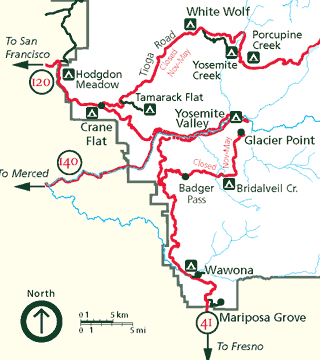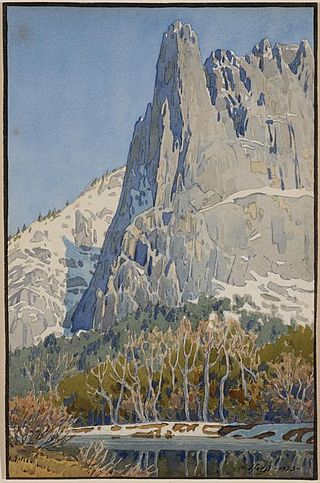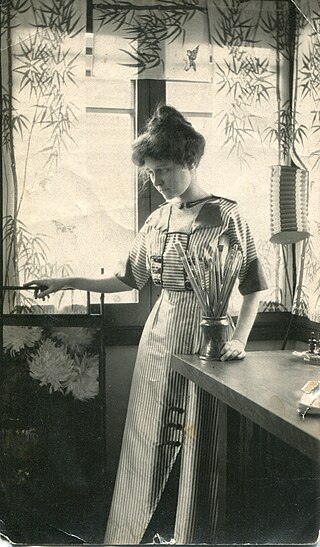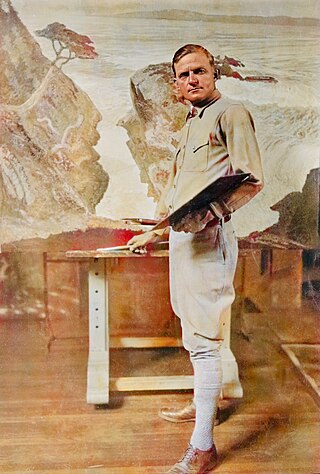
Wawona is a census-designated place in Mariposa County, California, United States. The population was 111 at the 2020 census.

Mariposa Grove is a sequoia grove located near Wawona, California, United States, in the southernmost part of Yosemite National Park. It is the largest grove of giant sequoias in the park, with several hundred mature examples of the tree. Two of its trees are among the 30 largest giant sequoias in the world. The grove closed on July 6, 2015, for a restoration project and reopened on June 15, 2018.

Human habitation in the Sierra Nevada region of California reaches back 8,000 to 10,000 years ago. Historically attested Native American populations, such as the Sierra Miwok, Mono and Paiute, belong to the Uto-Aztecan and Utian phyla. In the mid-19th century, a band of Native Americans called the Ahwahnechee lived in Yosemite Valley. The California Gold Rush greatly increased the number of non-indigenous people in the region. Tensions between Native Americans and white settlers escalated into the Mariposa War. As part of this conflict, settler James Savage led the Mariposa Battalion into Yosemite Valley in 1851, in pursuit of Ahwaneechees led by Chief Tenaya. The California state military forces burned the tribe's villages, destroyed their food stores, killed the chief's sons, and forced the tribe out of Yosemite. Accounts from the Mariposa Battalion, especially from Dr. Lafayette Bunnell, popularized Yosemite Valley as a scenic wonder.

Galen Clark was a Canadian-born American conservationist and writer. He is known as the first European American to discover the Mariposa Grove of Giant Sequoia trees, and is notable for his role in gaining legislation to protect it and the Yosemite area, and for 24 years serving as Guardian of Yosemite National Park.

The Wawona Hotel is a historic hotel located within southern Yosemite National Park, in California. It was declared a National Historic Landmark in 1987, and is on the National Register of Historic Places.
Percy Gray was an American painter. At the 1915 Panama–Pacific International Exposition he won a bronze medal for his watercolor Out of the Desert, Oregon.

Guy Orlando Rose was an American Impressionist painter and California resident, who received national recognition in the late 19th and early 20th centuries.

The Wawona Tree, also known as the Wawona Tunnel Tree, was a famous giant sequoia that stood in Mariposa Grove, Yosemite National Park, California, USA, until February 1969. It had a height of 227 feet (69 m) and was 26 feet (7.9 m) in diameter at the base.

William Keith was a Scottish-American painter famous for his California landscapes. He is associated with Tonalism and the American Barbizon school. Although most of his career was spent in California, he started out in New York, made two extended study trips to Europe, and had a studio in Boston in 1871–72 and one in New York in 1880.

The Yosemite Museum is located in Yosemite Valley in Yosemite National Park in California. Founded in 1926 through the efforts of Ansel Franklin Hall, the museum's displays focus on the heritage and culture of the Ahwahnechee people who lived in the valley. The collection also includes both utilitarian and made-for-sale baskets dating from c. 1870 to present and is one of the only existing collections encompassing this depth and time span for any group in California.

Gunnar Mauritz Widforss was a Swedish American artist who specialized in painting subjects from the wilderness in watercolor. Widforss is most frequently associated with landscapes from American National Parks.

Mary Agnes Yerkes,, was an American impressionist painter, photographer and artisan. She was skilled in the media of oil, pastel and watercolor. Her professional career was cut short by the Great Depression, but she still continued to paint well into her nineties with a passion for her craft and nature. She is noted for her plein-air painting while camping the American West and its National Parks.

Francis John McComas (1875–1938) was an Australian-born artist who spent most of his adult life in California, receiving some national recognition. He was one of the few California artists invited to exhibit in the 1913 International Exhibition of Modern Art in New York.

The Chris Jorgensen Studio is a one-room log building, built in 1904 as an artist's studio for Chris Jorgensen in the Yosemite Valley. Jorgensen, an instructor and assistant director of the California School of Fine Arts, arrived in Yosemite in the 1890s. Jorgensen studied and depicted local Native Americans from 1899, collecting native basketwork. The National Park Service acquired the Jorgensen Studio in 1919, calling it the Yosemite Museum. Jorgensen donated his basket collection to the museum in 1923. Jorgensen's widow, Angela Ghiardelli, donated many of Jorgensen's works to the museum following his death in 1935.
Charles Dorman Robinson was an American panorama, cyclorama, landscape, and marine painter. He is known for his seascapes and landscapes of Northern California, including over a hundred paintings of Yosemite Valley. He was known as "the dean of Pacific Coast artists".

Samuel Bolton Colburn was an experimental artist, evolving a modernist approach to landscape and genre scenes during the Depression era. In the 1930s California became known nationally for its Regionalist painters like Colburn, who depicted urban and rural views of native life. These artists’ preferred medium was watercolor and they worked quickly outdoors on location developing a painting style that was spontaneous, gestural and raw.

Sydney Jones Yard was an American painter who became one of the most famous watercolor artists in the United States, and the first professional artist to settle in the new community of Carmel-by-the-Sea, California.

The La Playa Hotel, also known as the "Grande Dame of Carmel," is a historic two-story hotel in Carmel-by-the-Sea, California, once owned by artist Chris Jorgensen. The building is an example of Mediterranean Revival architecture. The building qualified as an important commercial building and was registered with the California Register of Historical Resources on September 21, 2002.

The Forest King was a giant sequoia tree located in Nelder Grove, California that was cut down in 1870 and taken on a touring exhibit in the United States. This tree was the first of its kind to be felled for exhibition, unlike earlier trees such as the Mother of the Forest from Calaveras Grove where only bark was removed. This act sparked public outcry and would lead to the founding of national parks and the protection of giant sequoias through the nascent conservation movement.

Ferdinand Burgdorff,, also known as Ferdy, was an American etcher, painter, and printmaker. He was nationally known for his role as a landscape painter of the Monterey Peninsula, Yosemite, and the dessert Southwest. He was one of the earliest artist that came to the art colony in Carmel-by-the-Sea. He was an illustrator for Sunset Magazine. His works can be found in the permanent collections of the Naval Postgraduate School, De Young Museum, Monterey Museum of Art, and the Cleveland Museum of Art.



















